Advanced Grid Printing and Exporting
- 6 minutes to read
The report generation feature provides an advanced way to print and export your WinForms Grid Control data. You can easily generate a report from the grid data either at design time or at runtime, taking into account the grid layout. During report generation, it is possible to specify print appearance settings and control which grid elements are added to the report.
You can then modify the generated report as required, delegate report customization to an end-user, send the report to a printer or export it to various formats, and allow the end-user to do this manually.
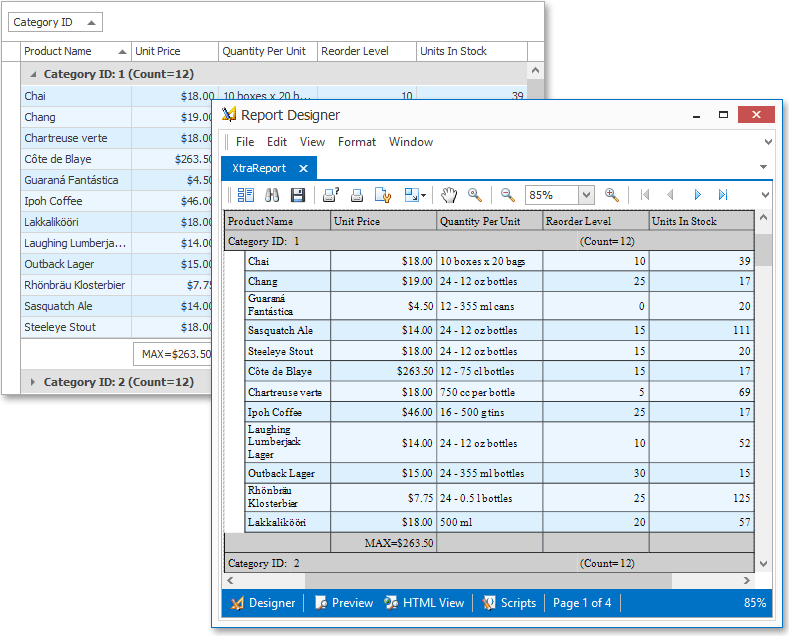
Note
The report generation feature is supported for the following GridControl Views: GridView, BandedGridView and AdvBandedGridView.
The following sections provide details on how to generate and use grid reports.
- Supported Grid Features
- Limitations
- Generating a Report at Design Time
- Scenarios of Using the Generated Report
- Generating a Report in Code
Supported Grid Features
The report generation engine takes into account the following grid features and settings.
- Binding settings of columns.
- Unbound columns, whose values are calculated based on expressions. See GridColumn.UnboundExpression.
- Group, sort and filter settings.
- Group and total summaries.
- Appearance of columns (GridColumn.AppearanceHeader and GridColumn.AppearanceCell).
- Appearance of rows
- Conditional formatting rules that are based on expressions.
- Grid bands (when exporting data from BandedGridView and AdvBandedGridView).
- Sparklines (embedded into grid cells)
- Boolean column values are presented by check boxes in the output report.
Limitations
The following features are not supported by the report generation engine.
- Unbound columns populated using the ColumnView.CustomUnboundColumnData event.
- Any customization made using grid events.
- Conditional formatting rules that are not based on expressions.
Generating a Report at Design Time
To generate a report based on GridControl‘s data at design time, do the following.
Locate the ReportGenerator component in the Toolbox and drag-and-drop it onto the application form.
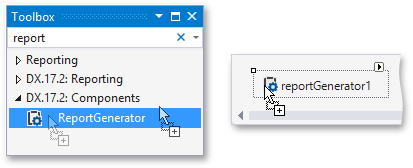
Click the ReportGenerator’s smart tag and select Generate Report.

On the first page of the invoked Report Wizard, select the GridControl’s View for which the report is to be generated and click Next.
Note
Currently, reports can only be generated for GridViews, BandedGridViews and AdvBandedGridViews.

The next wizard page allows you to select the grid elements to be included in the report.
- Print Column Headers - Specifies whether to add column headers to the report.
- Print Total Summary Footer - Specifies whether to add the summary footer to the report.

The preview pane immediately reflects the changes made to the options. Click Next.
This wizard page allows you to specify data grouping-specific settings.
- Print Group Rows - Specifies whether to include group rows in the report.
- Print Group Summary Footer - Specifies whether to add group footers to the report.
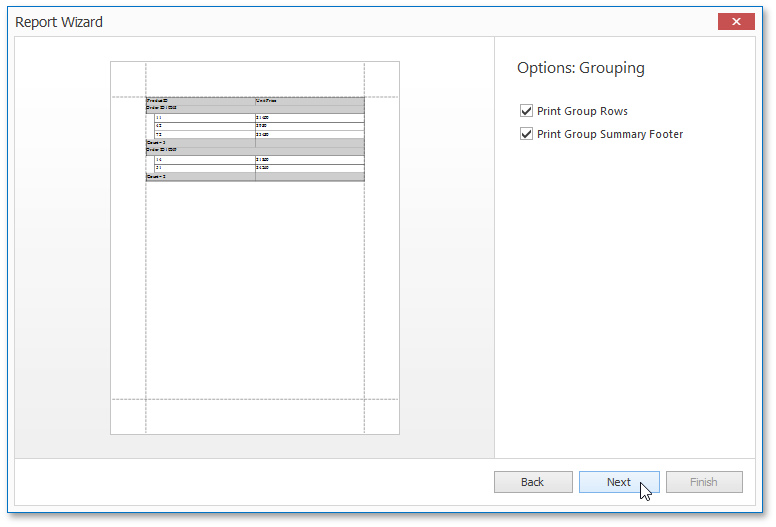
In the Styles wizard page, choose whether dedicated print styles or default styles should be used when generating a report. The preview shows how these options change the report’s appearance.
- Use Print Appearances - Specifies whether dedicated print appearance settings (GridView.AppearancePrint) or regular appearance settings (GridView.Appearance) are used when generating a report.
- Enable Even Row Print Appearance - Specifies whether even rows in the resulting report are painted using the appearance settings provided by the GridViewPrintAppearances.EvenRow property. This option is in effect if the Use Print Appearances setting is enabled.
- Enable Odd Row Print Appearance - Specifies whether odd rows in the resulting report are painted using the appearance settings provided by the GridViewPrintAppearances.OddRow property. This option is in effect if the Use Print Appearances setting is enabled.
- Print Vertical Lines - Specifies the visibility of vertical grid lines in the report.
- Print Horizontal Lines - Specifies the visibility of horizontal grid lines in the report.

In the next page, specify the title for the generated report and click Finish to complete the wizard.
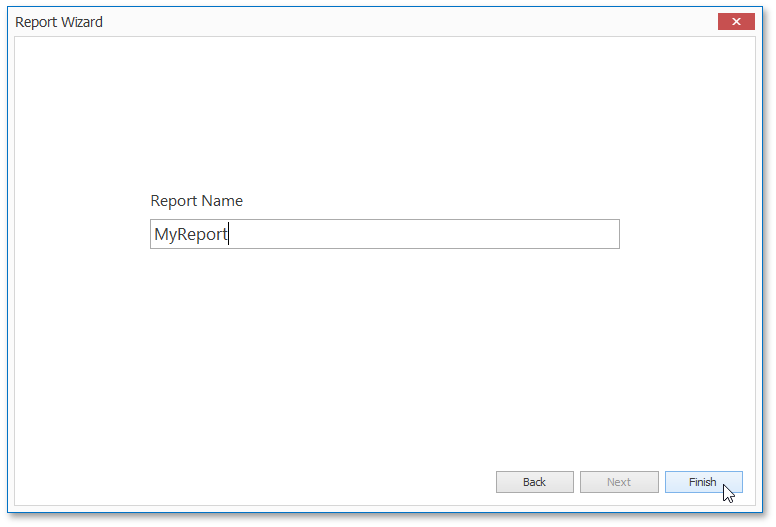
Scenarios of Using the Generated Report
The generated report is automatically added to the current project under the specified name and opened in the advanced Report Designer, which is fully integrated into the Visual Studio IDE. The report’s declaration can be found in the file with the same name as the report name.
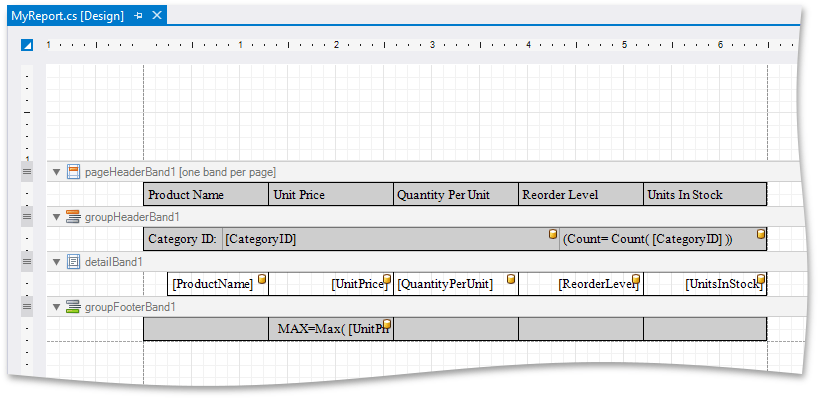
The report designer provides rich creating, editing and publishing capabilities including the following.
- Print, Print Preview, and Export actions
- Modifying report element layouts
- Modifying report element appearances
- Applying data grouping, sorting and filtering
- Adding totals
- Adding page numbers and system information
- etc.
See the Visual Studio Report Designer document for more information about report design-time customization.
After the report is generated and customized, you can show the report’s print preview to your end-users.
It is possible to delegate report customization to end-users. They can use the End-User Report Designer to manually modify the report, show a Print Preview, export the report, etc. For more information, refer to the Report Designer document.
The following code creates a new instance of the generated report class and opens it in the End-User Report Designer.
using DevExpress.XtraReports.UI;
//...
MyReport report = new MyReport();
ReportDesignTool designTool = new ReportDesignTool(report);
designTool.ShowDesignerDialog();
Generating a Report in Code
At runtime, a report can be generated using the static ReportGenerator.GenerateReport method of the ReportGenerator class.
using DevExpress.XtraReports.ReportGeneration;
// ...
XtraReport report = ReportGenerator.GenerateReport(gridView1);
When generating a report in code, you can also take into account dedicated report generation options (those that are available in the Report Generation Wizard). To do this, create a ReportGenerationOptions class instance, set its appropriate properties and pass it as the last parameter to the GenerateReport method.
ReportGenerationOptions options = new ReportGenerationOptions();
options.PrintGroupSummaryFooter = DefaultBoolean.False;
// ...
XtraReport report = ReportGenerator.GenerateReport(gridView1, options);
To take advantage of binding expressions, use the ReportGenerator.GenerateReport method with the useExpressionBindings Boolean parameter set to true. Binding expressions provide advanced capabilities for further customization of the generated report. See Data Binding Modes to learn more.